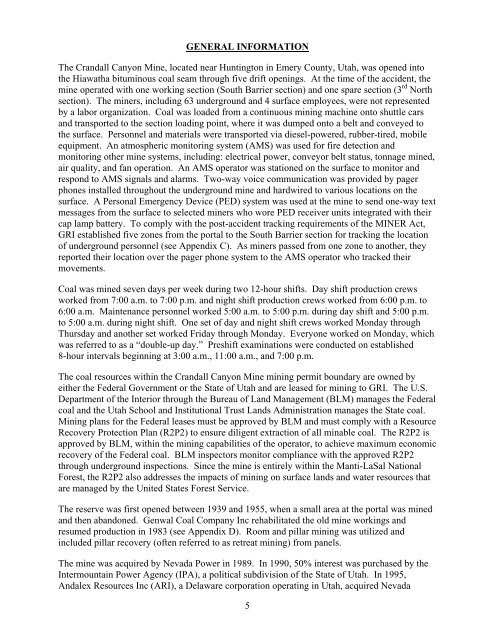Mine Safety and Health Administration (MSHA) - Report of ...
Mine Safety and Health Administration (MSHA) - Report of ...
Mine Safety and Health Administration (MSHA) - Report of ...
Create successful ePaper yourself
Turn your PDF publications into a flip-book with our unique Google optimized e-Paper software.
GENERAL INFORMATION<br />
The Cr<strong>and</strong>all Canyon <strong>Mine</strong>, located near Huntington in Emery County, Utah, was opened into<br />
the Hiawatha bituminous coal seam through five drift openings. At the time <strong>of</strong> the accident, the<br />
mine operated with one working section (South Barrier section) <strong>and</strong> one spare section (3 rd North<br />
section). The miners, including 63 underground <strong>and</strong> 4 surface employees, were not represented<br />
by a labor organization. Coal was loaded from a continuous mining machine onto shuttle cars<br />
<strong>and</strong> transported to the section loading point, where it was dumped onto a belt <strong>and</strong> conveyed to<br />
the surface. Personnel <strong>and</strong> materials were transported via diesel-powered, rubber-tired, mobile<br />
equipment. An atmospheric monitoring system (AMS) was used for fire detection <strong>and</strong><br />
monitoring other mine systems, including: electrical power, conveyor belt status, tonnage mined,<br />
air quality, <strong>and</strong> fan operation. An AMS operator was stationed on the surface to monitor <strong>and</strong><br />
respond to AMS signals <strong>and</strong> alarms. Two-way voice communication was provided by pager<br />
phones installed throughout the underground mine <strong>and</strong> hardwired to various locations on the<br />
surface. A Personal Emergency Device (PED) system was used at the mine to send one-way text<br />
messages from the surface to selected miners who wore PED receiver units integrated with their<br />
cap lamp battery. To comply with the post-accident tracking requirements <strong>of</strong> the MINER Act,<br />
GRI established five zones from the portal to the South Barrier section for tracking the location<br />
<strong>of</strong> underground personnel (see Appendix C). As miners passed from one zone to another, they<br />
reported their location over the pager phone system to the AMS operator who tracked their<br />
movements.<br />
Coal was mined seven days per week during two 12-hour shifts. Day shift production crews<br />
worked from 7:00 a.m. to 7:00 p.m. <strong>and</strong> night shift production crews worked from 6:00 p.m. to<br />
6:00 a.m. Maintenance personnel worked 5:00 a.m. to 5:00 p.m. during day shift <strong>and</strong> 5:00 p.m.<br />
to 5:00 a.m. during night shift. One set <strong>of</strong> day <strong>and</strong> night shift crews worked Monday through<br />
Thursday <strong>and</strong> another set worked Friday through Monday. Everyone worked on Monday, which<br />
was referred to as a “double-up day.” Preshift examinations were conducted on established<br />
8-hour intervals beginning at 3:00 a.m., 11:00 a.m., <strong>and</strong> 7:00 p.m.<br />
The coal resources within the Cr<strong>and</strong>all Canyon <strong>Mine</strong> mining permit boundary are owned by<br />
either the Federal Government or the State <strong>of</strong> Utah <strong>and</strong> are leased for mining to GRI. The U.S.<br />
Department <strong>of</strong> the Interior through the Bureau <strong>of</strong> L<strong>and</strong> Management (BLM) manages the Federal<br />
coal <strong>and</strong> the Utah School <strong>and</strong> Institutional Trust L<strong>and</strong>s <strong>Administration</strong> manages the State coal.<br />
Mining plans for the Federal leases must be approved by BLM <strong>and</strong> must comply with a Resource<br />
Recovery Protection Plan (R2P2) to ensure diligent extraction <strong>of</strong> all minable coal. The R2P2 is<br />
approved by BLM, within the mining capabilities <strong>of</strong> the operator, to achieve maximum economic<br />
recovery <strong>of</strong> the Federal coal. BLM inspectors monitor compliance with the approved R2P2<br />
through underground inspections. Since the mine is entirely within the Manti-LaSal National<br />
Forest, the R2P2 also addresses the impacts <strong>of</strong> mining on surface l<strong>and</strong>s <strong>and</strong> water resources that<br />
are managed by the United States Forest Service.<br />
The reserve was first opened between 1939 <strong>and</strong> 1955, when a small area at the portal was mined<br />
<strong>and</strong> then ab<strong>and</strong>oned. Genwal Coal Company Inc rehabilitated the old mine workings <strong>and</strong><br />
resumed production in 1983 (see Appendix D). Room <strong>and</strong> pillar mining was utilized <strong>and</strong><br />
included pillar recovery (<strong>of</strong>ten referred to as retreat mining) from panels.<br />
The mine was acquired by Nevada Power in 1989. In 1990, 50% interest was purchased by the<br />
Intermountain Power Agency (IPA), a political subdivision <strong>of</strong> the State <strong>of</strong> Utah. In 1995,<br />
Andalex Resources Inc (ARI), a Delaware corporation operating in Utah, acquired Nevada<br />
5
















